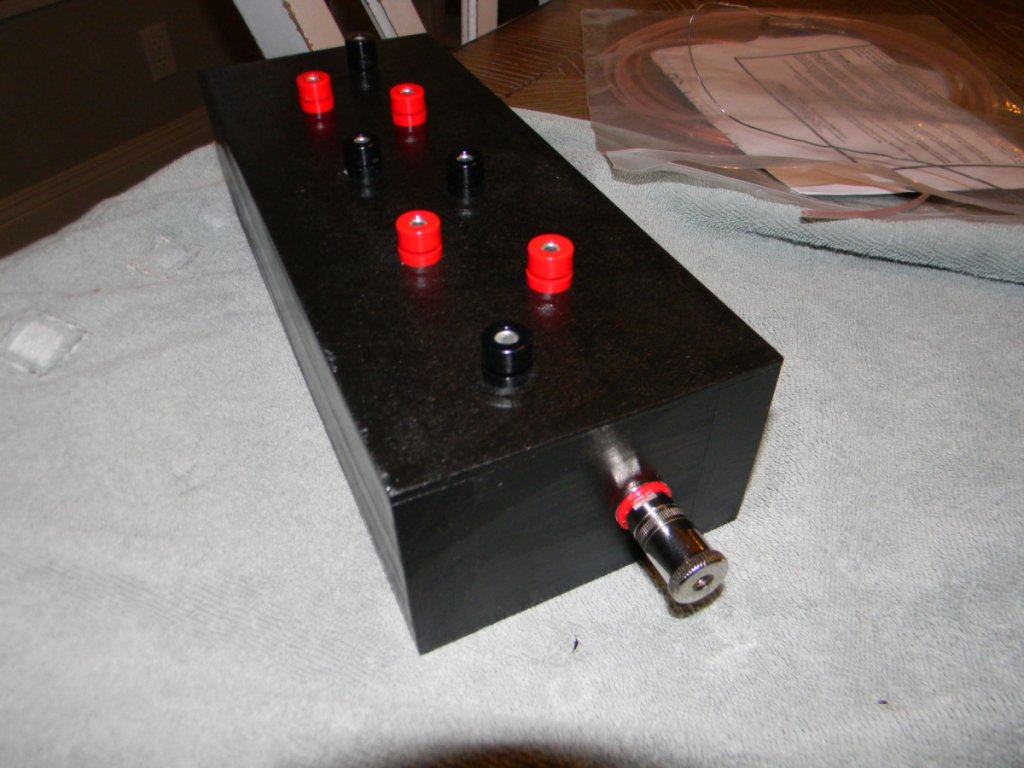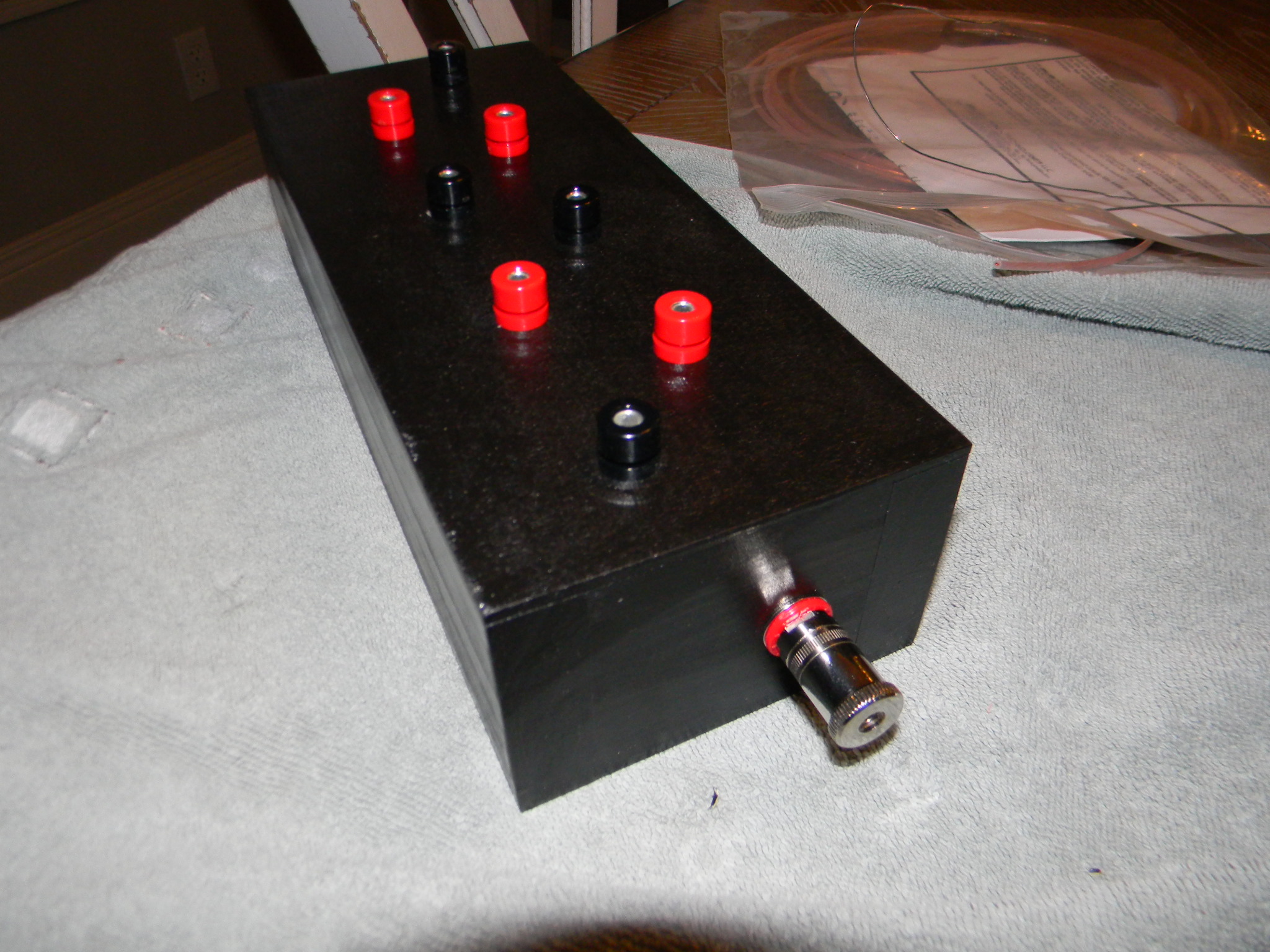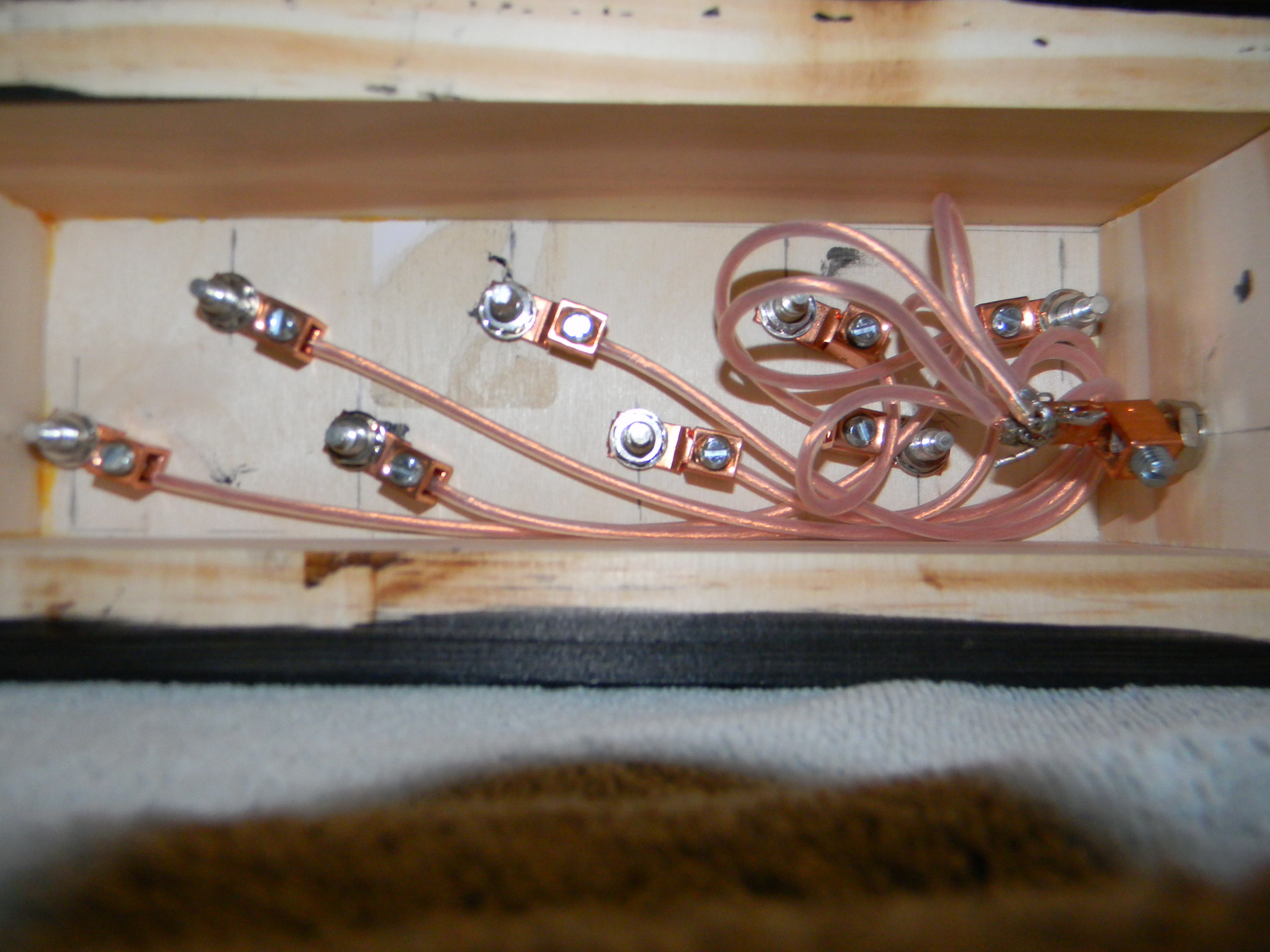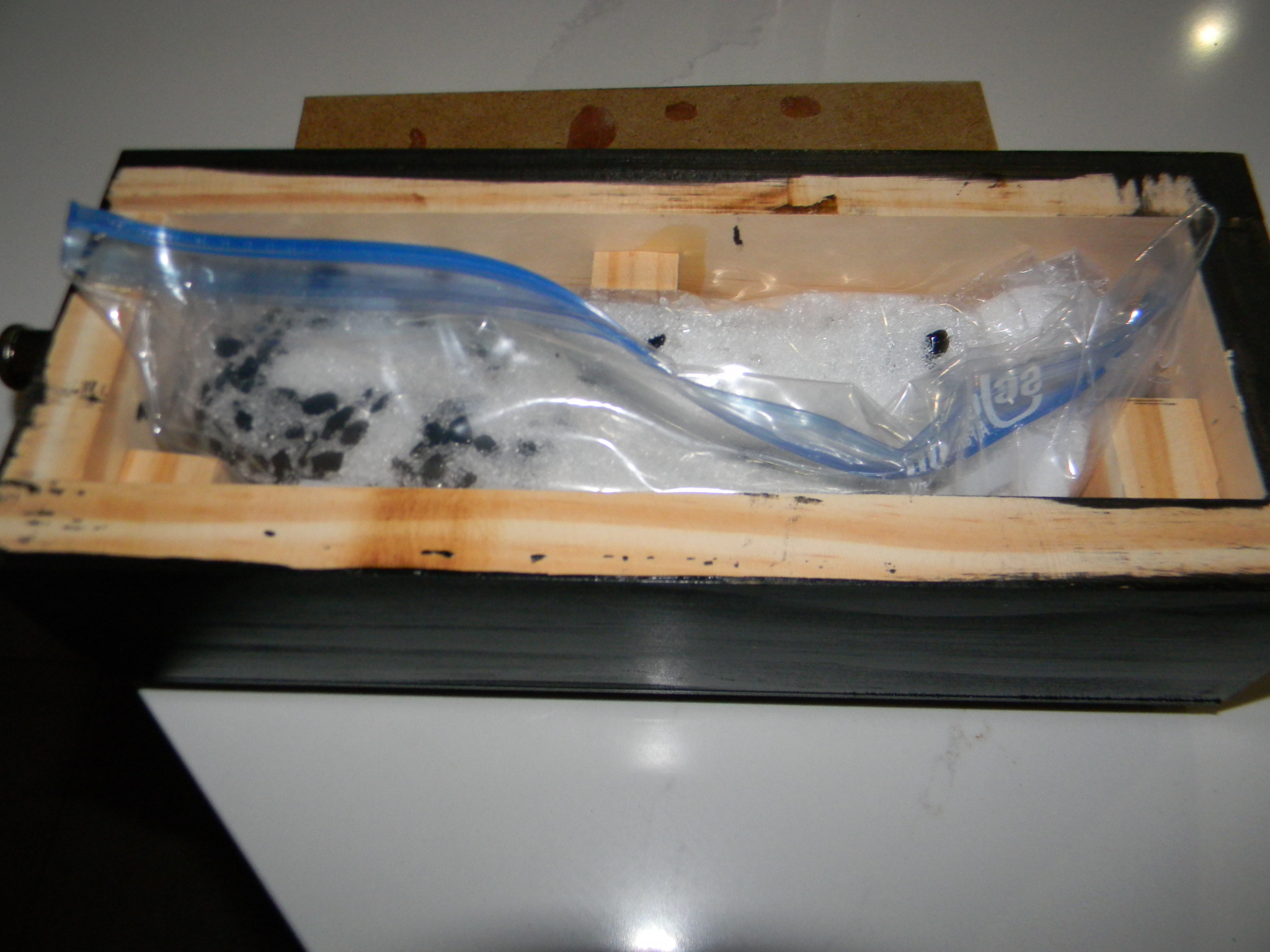I borrowed ingredients from you folks and decided to mix them with potting soil. I looked at topsoil, but it is filled with sticks and twigs. Once you mix in the shungite, magnesium, carbon, and copper chop, it takes on a much different consistency. I also packed it into the spaces and then I laid a piece of EMI absorbing sheet inside each cover before attaching.
|
|
|
One unit screwed together
|
|
Getting there. I still have to make the silver cables to complete this project and take it for a spin. It's been very difficult to find the time to get this completed.
The insides of my boxes are like battery plates. I made a "square" and a "tall" unit. I have silver plated (presumably silver) connections and I also put an "output" jack as well. Copper sheet and aluminum sheet with a conductive media.
|
|
 

Some weight to the box via a bag of quartz and tourmaline.

|
I wired it with some Jena Labs wire I had left over from another project.
|
Ralph is spot on. Get your ohmmeter out and discover how your connections are connected to either one another or to ground.
I have 2 earth ground rods. The first is purely the Puritan unit green ground wire through the Groundmaster device.
The second ground rod takes all my "signal grounds" out via a DIY ground box. But note that the signals are in many cases connected to the power ground through the chassis. A potential ground loop situation. So I ran a separate ground rod to make it a longer path, so to speak. I only use 12 ga "Romex" for each rod wire. About 20 feet for each to get me to Mother earth.
I’ll try to attach some photos of my DIY box. I braid 18 or 20 ga wire for my cables from components to the box to make it look sexier and use alligator clips or banana jacks.
I am only 20% successful posting pics here.
|
|
Rochelle salts are getting difficult to find lately.
I also use the 3M EMI absorbing material with the adhesive backing in my boxes, usually on the last surface away from the item being "absorbed".
|
Agree Ozzy, but with your meter you may be surprised that the signal grounding is part of the chassis which may also be the AC grounding. Pull your power cable and check the exterior or the RCA connectors to the ground plug and you may find they are the same.
|
Yes, the ground of your AC IEC can be the chassis, which can also be the signal ground of an RCA connector. So saying we keep them separate, which I also try to do with 2 ground rods, is kidding ourselves. So something to be aware of as Ralph pointed out, component manufacturers have vastly different schemes. So beware.
I use the Puritan out through the Groundmaster to a rod in mother earth. I ran a separate ground rod for the signal grounds, but in my case they are the same as some of the power grounds. So creating a loop is a risk. I cannot say I have done that but with 2 rods outside I find it hard to believe they will travel back, especially with Groundmaster in place.
|
I would think that would bypass the Entreq altogether and go straight to ground. I think as an experiment you might find direct to the ground in the outlet would be better than the Entreq.
I made an adapter from a spare male plug and attached a banana jack to the back side with only a wire from it to the ground pin of the Furutech male wall plug so I only connected the banana to ground via the plug. Then I could stack up plugs to experiment with. Now I use my new black ground box instead going to earth and a copper rod instead.
I believe Entreq's and other boxes are full of stuff simulating earth because most folks don't have the acumen to mess with wires and ground rods and wall outlets.
|
Are you connecting to the negative terminal of the speakers only with a standalone box for "passive' absorption? If powered speakers, I would guess you cannot connect the neg terminal to a ground of a duplex?
|
Ozzy, have you tried your grounding direct ot the duplex ground and w/o the Entreq?
|
I cannot anticipate any auditory benefit on a ground wire.😏
|
I was speaking to the HF NS 1260 compound. Yes, reducing noise is auditory but the compound should not be needed for this activity.
|
Ozzy, it sounded like you were thinking about running a wire from the Entreq to the duplex ground. That would seem to defeat the Entreq as the path of least resistance would be the component to the duplex ground. So why not just try the duplex ground or ground rod w/o the Entreq to see if they are equal in reducing noise? I believe these purchased boxes are no more than representatives of our earth(dirt, etc.) and the cheapest way to replicate them is to go straight to ground. The bigger the boxes, the better the reduction, i.e. the more "dirt" they represent.🤷♂️
I'll try grounding my negative speaker terminal to earth ground rod this weekend after I change out the purple fuses first in case there is a short I am not anticipating. I have tried grounding the mounting bolts of the drivers to the earth rod with zero effect.
|
One is about 8x8x4. The other I thought I would experiment with longer and fewer runs of metal. It is closer to 15x7x4. The metal strips are all 2 inches and the MDF is 1/2", hence the 4 inch box depth. I was trying to have a greater amount of copper versus aluminum but not by much in the end.
I was not sure on running through the box as dead-heading is safer and avoids any ground loops. But I put it in out of curiosity and perhaps running to ground might add some performance. But if it does, why not just use a filter network instead of box full of dirt and minerals?
|
|
I would not connect your negative terminal to anything electrical ground (which would include a copper pipe in many homes). You will have a ground loop and it will be unpleasant for your gear.
Proceed with caution.
Ozzy, is anything else connected to the box, or just the one speaker negative to one box that is its own terminus?
|
This looks like a galvanic cell as opposed to a battery. So something as simple as a copper wire with aluminum sheet that makes the current pass through a conductive medium like graphene or the like should draw "noise" out of the wire to the larger surface of aluminum or equivalent. Still researching.
|
So if you had a cathodic metal like silver on the outside of the box the voltage would want to flow back out if the inside had aluminum plates in a conductive medium inside. So this does not make sense from a galvanic circuit.
Can't we just cut somebody's Entreq in two and we'll have our answers!
|
I would say my boxes should be reworked with a more conductive media like graphene or powdered carbon.
|
pedroeb:
I think your situation is exactly what these boxes are for.
Ozzy, the Entreqs did not have plates in them? I assumed, as they state, a battery-looking device that collects voltage in reverse of how a battery with cathode and anode plates works.
|
Shungite - check.
Where can you get pounds of graphene or carbon, not grams?
I'm wondering if the high conductivity of silver is the real need in the cables due to the low levels of the signals (noise). Certainly low current and low voltage but losses along the wire will not help it escape, so to speak.
|
The green wire is meant to connect to the Puritan unit when using a Groundmaster. It takes all the power grounds out to the earth rod.
On the city version I think it connects to the Puritan and then to a duplex via its ground connection. So, almost "earth ground", but more the electrical ground in the dwelling.
|
I see you guys built your boxes like I did except we used different conductive media. I think I am going to try the reverse battery arrangement and lead in with plates like copper or stainless that are isolated from the rest of the box. Then I will put aluminum plates that do not touch the copper plates but use the conductive media to make the "circuit". It will take me a few weeks to do this. It will also be messy since the powder will be messy to reuse if this is a failure.
|
I ordered a Russ Andrews RF Router MKII for my signal grounds going to separate ground rod.
BTW, the Groundmaster is potted so you cannot decipher its guts other than the faint outline of caps in the potting.
|
The best explanation you can give is a demo. So make it a good one.
I've got ingredients on the way to make one box. One lousy box. I will have to find some sources for 5 gallon buckets of minerals to build 4 or 5 more if these work out. Of course with all the Russia stuff going on, I don't dare try and buy large quantities of Shungite from there at much better prices than the health outfits who sell it at a premium in small quantities.
I'm going to set up my box with a possible drain out the back side that I could additionally take to ground. That is why I ordered the Russ Andrews unit to see how his circuit functions compared to the Groundmaster.
|
|
I plan to use silver wire going into copper plates inside as they are on the same end of the galvanic scale. Then I am planning to use aluminum plates on the other end of the scale to create the "pull" across the conductive media.
|
Sure, once I have something worth trying. I will be using MDF for the box so I can open it up and re-configure if needed.
The Andrews box should be here this week.
|
|
I'm going to try one wide and one tall. Planning to stand them up to save floor space. Some progress on these prototype boxes.
|
|
One thing I did try last weekend was putting the Andrews device in and connecting the neg from my Wilsons and that produced a nice subtle buzz. So, a no-go on the Wilsons going to earth ground.
So now I have all my other signal grounds in the Andrews unit.
It's been a hectic week. Company visitors and a leaky pipe that took me 2 nights to repair. Now I'm paying my KY taxes.
|
|
Yes, I have 2 earth rods. One for AC grounding from the Puritan and one for signal grounds via the Russ unit.
So far the biggest gains for me have been the 2 ADD-PWR Wizards I use. The music is so addicting I could care less about noise. But I like to tinker so I'll carry on. I'm sure I'll get time to get those boxes going this weekend.
I also owe Jeff Smith a call so we can kibitz about grounding.
|
Similar to my incident. Must be making a ground loop. Don't forget, many chassis grounds can be signal grounds on some devices. My amp's ground to the wall is also the chassis and XLR grounds.
Here is a simple device I made with a spare Furutech clamshell plug and banana jack. Takes the banana plug straight to ground only (one wire inside). With the clamshell you can grab the banana nut and hold it tight to the plastic shell when you close it up.

|
It would never be an empty box. It would have to have filters for certain frequencies and perhaps some diodes to let the noise escape and not return.
I never said the Andrews was an empty box.
|
|
Ozzy, have you determined what kind of ground is going to the box? Are you connecting in series or parallel?
If your box is a chassis ground or otherwise an electrical ground then you would be creating a loop no matter what the device is.
If your signal ground is not part of the AC ground of the device then you will be okay. Have you checked all your ground points to the AC ground pin on the IEC of your devices first to determine which is truly a signal and which are AC grounds?
To repeat, on my amp, the ground of the iec on the amp is exactly the exterior of the XLR connectors and the chassis itself. So therefore, they are AC grounds and already being dumped through your power cable. If you try and "ground" them once again via a box, that is okay. If you then tie the box banana to an outlet ground, that is creating a buzz because it is a ground loop.
|
It is essentially a Groundmaster. I wanted one to have a filter before my second earth rod (and to give his a try) for my signal grounds
So, are your amps and subs signal negatives for sure not chassis?.
|
The Bricasti dac I use does not connect the outer shell of the RCA's and XLR's to the power ground pin on the power cable. So they are only signal grounds.
On my amp, the case, XLR's and power input ground pin are all the same, so there is no chance of having a signal-only "ground" unless my device is a dead end box with magic crystals and does not connect to ground.
Ozzy, have you put your ohmmeter across the rca's of your sub and the power pin of the iec for the power cable? If there is a short, then the RCA's are connected to ground via the power cable. In that case, trying to connect the grounding box to a outlet ground would create a loop.
|
The Andrews should have a filter network in it like the Groundmaster to make sure what goes in does not came back through.
|
|
|





